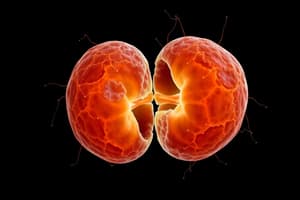Podcast
Questions and Answers
What is the primary purpose of mitosis in multicellular organisms?
What is the primary purpose of mitosis in multicellular organisms?
- To increase the size of the parent cell
- To produce two daughter cells that are genetically identical to the parent cell (correct)
- To produce genetically diverse cells
- To repair damaged tissues
During which stage of mitosis do the chromosomes condense further and become visible as distinct structures?
During which stage of mitosis do the chromosomes condense further and become visible as distinct structures?
- Interphase
- Prophase (correct)
- Metaphase
- Anaphase
What is the term for the complex of DNA, histone proteins, and other non-histone proteins that make up the chromosome?
What is the term for the complex of DNA, histone proteins, and other non-histone proteins that make up the chromosome?
- Sister chromatids
- Centromere
- Spindle fibers
- Chromatin (correct)
During which stage of mitosis do the sister chromatids separate, moving to opposite poles of the cell?
During which stage of mitosis do the sister chromatids separate, moving to opposite poles of the cell?
What is the region of the chromosome where the spindle fibers attach?
What is the region of the chromosome where the spindle fibers attach?
During which stage of mitosis does the cytoplasm divide, and the cell splits into two daughter cells?
During which stage of mitosis does the cytoplasm divide, and the cell splits into two daughter cells?
Flashcards are hidden until you start studying
Study Notes
Definition and Purpose
- Mitosis is the process of cell division that results in two daughter cells that are genetically identical to the parent cell.
- It is a crucial aspect of growth, development, and tissue repair in multicellular organisms.
Stages of Mitosis
- Interphase
- Cell grows, replicates its DNA, and prepares for cell division.
- Chromatin condenses into visible chromosomes.
- Prophase
- Chromosomes condense further and become visible as distinct structures.
- Nuclear envelope breaks down, and spindle fibers form.
- Metaphase
- Chromosomes line up at the center of the cell, attached to the spindle fibers.
- Each chromosome is aligned with its identical partner.
- Anaphase
- Sister chromatids separate, moving to opposite poles of the cell.
- Spindle fibers contract, pulling the sister chromatids apart.
- Telophase
- Chromosomes reach the poles and begin to decondense.
- Nuclear envelope reforms around each set of chromosomes.
- Cytokinesis
- Cytoplasm divides, and the cell splits into two daughter cells.
Key Concepts
- Chromatin: The complex of DNA, histone proteins, and other non-histone proteins that make up the chromosome.
- Sister chromatids: Identical copies of a chromosome that are connected at the centromere.
- Spindle fibers: Protein structures that attach to the centromere of each chromosome and pull them apart during anaphase.
- Centromere: The region of the chromosome where the spindle fibers attach.
Mitosis vs. Meiosis
- Mitosis results in two genetically identical daughter cells, while meiosis results in four genetically unique daughter cells.
- Mitosis occurs in somatic cells, while meiosis occurs in reproductive cells.
Definition and Purpose
- Mitosis is the process of cell division that results in two genetically identical daughter cells.
- It is crucial for growth, development, and tissue repair in multicellular organisms.
Stages of Mitosis
- During interphase, the cell grows, replicates its DNA, and prepares for cell division.
- Chromatin condenses into visible chromosomes during interphase.
- In prophase, chromosomes condense further, become visible as distinct structures, and the nuclear envelope breaks down.
- Spindle fibers form during prophase.
- In metaphase, chromosomes line up at the center of the cell, attached to the spindle fibers.
- Each chromosome is aligned with its identical partner during metaphase.
- In anaphase, sister chromatids separate, moving to opposite poles of the cell.
- Spindle fibers contract, pulling the sister chromatids apart during anaphase.
- In telophase, chromosomes reach the poles and begin to decondense.
- The nuclear envelope reforms around each set of chromosomes during telophase.
- Cytokinesis is the final stage of mitosis, where the cytoplasm divides, and the cell splits into two daughter cells.
Key Concepts
- Chromatin is the complex of DNA, histone proteins, and other non-histone proteins that make up the chromosome.
- Sister chromatids are identical copies of a chromosome connected at the centromere.
- Spindle fibers are protein structures that attach to the centromere of each chromosome and pull them apart during anaphase.
- The centromere is the region of the chromosome where the spindle fibers attach.
Mitosis vs. Meiosis
- Mitosis results in two genetically identical daughter cells, while meiosis results in four genetically unique daughter cells.
- Mitosis occurs in somatic cells, while meiosis occurs in reproductive cells.
Studying That Suits You
Use AI to generate personalized quizzes and flashcards to suit your learning preferences.




